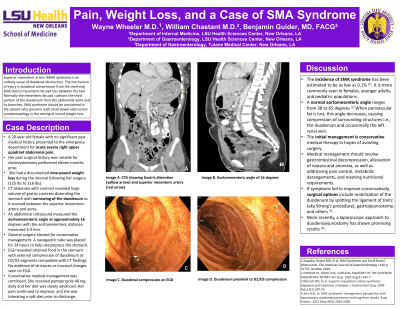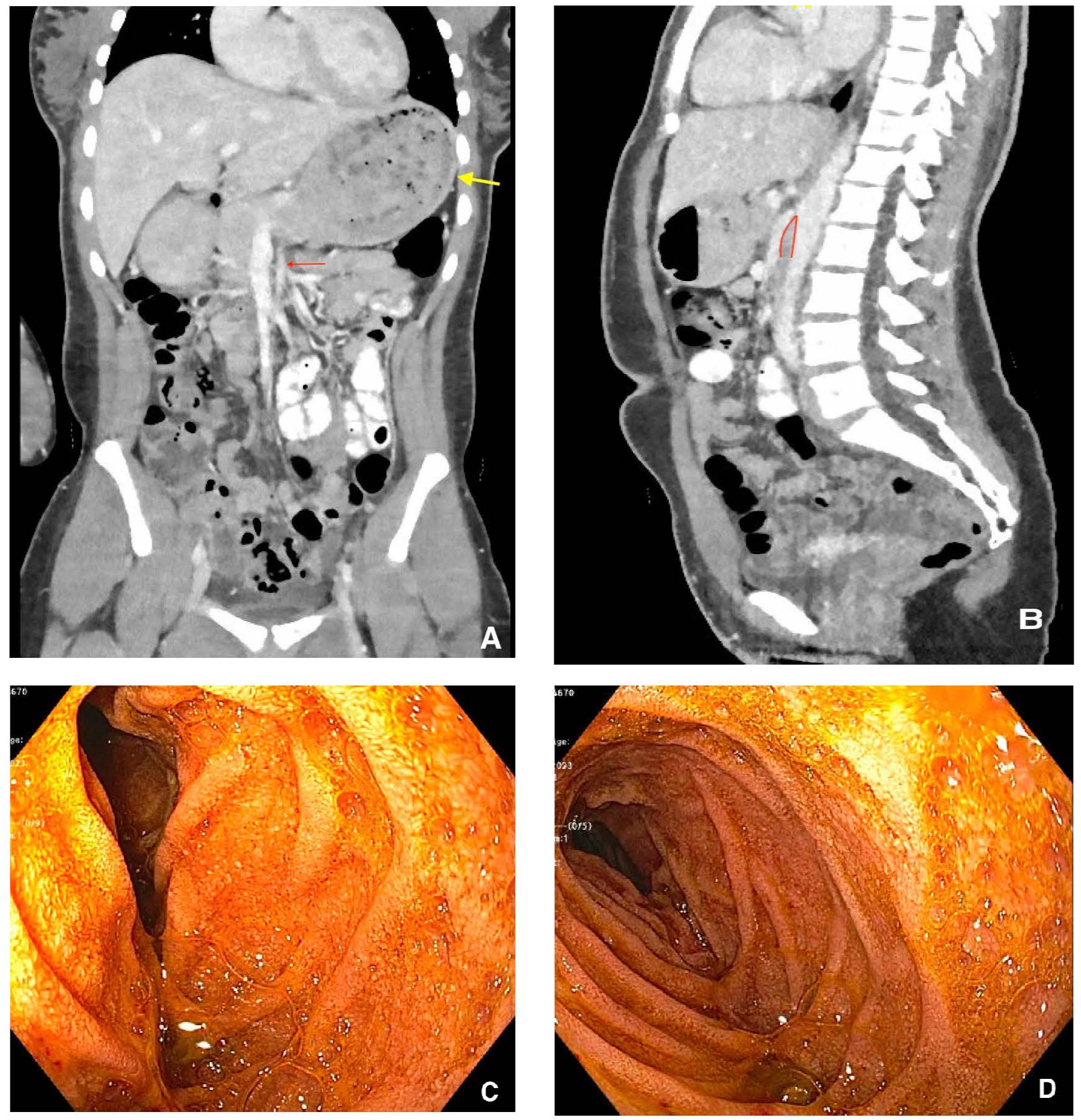Sunday Poster Session
Category: Small Intestine
P1326 - Pain, Weight Loss, and a Case of SMA Syndrome
Sunday, October 22, 2023
3:30 PM - 7:00 PM PT
Location: Exhibit Hall

Has Audio

Austin Wayne Wheeler, MD
LSU Health Sciences Center
New Orleans, LA
Presenting Author(s)
Austin Wayne Wheeler, MD1, William Chastant, MD2, Benjamin Guider, MD3
1LSU Health Sciences Center, New Orleans, LA; 2LSU, New Orleans, LA; 3Tulane, New Orleans, LA
Introduction: Superior mesenteric artery (SMA) syndrome is an unlikely cause of duodenal obstruction. The mechanism of injury is duodenal compression from the overlying SMA due to mesenteric fat pad loss between the two. Normally the mesenteric fat pad cushions the third portion of the duodenum from the abdominal aorta and its branches. SMA syndrome should be considered in the patient who presents with small bowel obstruction symptomatology in the setting of recent weight loss.
Case Description/Methods: A 20-year-old female with no significant past medical history presented to the emergency department for acute severe right upper quadrant abdominal pain. Her past surgical history was notable for cholecystectomy eleven months prior. She had a documented nine-pound weight loss during the interval following her surgery (125 lbs to 116 lbs). CT abdomen with contrast revealed large volume of gastric contents distending the stomach with narrowing of the duodenum as it coursed between the superior mesenteric artery and aorta. CT and ultrasound measured the aortomesenteric angle at 16 degrees with a 3-4 mm aortomesenteric distance. General surgery recommended conservative management. A nasogastric tube was placed for 24 hours to decompress the stomach. The next day an EGD revealed retained food in the stomach with external compression of duodenum at D2/D3 segments compatible with CT findings. No evidence of strictures or mucosal changes were seen on EGD. She received pantoprazole 40 mg daily and her diet was slowly advanced. Her pain continued to improve and she was tolerating a regular diet prior to discharge.
Discussion: The incidence of SMA syndrome has been estimated to be as low as 0.1%. It is more commonly seen in females and younger adults. A normal aortomesenteric angle ranges from 38 to 65 degrees. When perivascular fat is lost, this angle decreases, causing compression of nearby structures i.e. the duodenum and occasionally left renal vein. Initial management is conservative in hopes of avoiding surgery. Medical treatment may involve gastrointestinal decompression, as well as addressing pain control, metabolic derangements, and meeting nutritional requirements. If symptoms don't improve conservatively, surgical options should be considered. There are multiple surgical approaches, but growing evidence suggests a laparoscopic duodenojejunostomy as the procedure of choice. Fortunately for our patient, she responded to conservative management and remains well.

Disclosures:
Austin Wayne Wheeler, MD1, William Chastant, MD2, Benjamin Guider, MD3. P1326 - Pain, Weight Loss, and a Case of SMA Syndrome, ACG 2023 Annual Scientific Meeting Abstracts. Vancouver, BC, Canada: American College of Gastroenterology.
1LSU Health Sciences Center, New Orleans, LA; 2LSU, New Orleans, LA; 3Tulane, New Orleans, LA
Introduction: Superior mesenteric artery (SMA) syndrome is an unlikely cause of duodenal obstruction. The mechanism of injury is duodenal compression from the overlying SMA due to mesenteric fat pad loss between the two. Normally the mesenteric fat pad cushions the third portion of the duodenum from the abdominal aorta and its branches. SMA syndrome should be considered in the patient who presents with small bowel obstruction symptomatology in the setting of recent weight loss.
Case Description/Methods: A 20-year-old female with no significant past medical history presented to the emergency department for acute severe right upper quadrant abdominal pain. Her past surgical history was notable for cholecystectomy eleven months prior. She had a documented nine-pound weight loss during the interval following her surgery (125 lbs to 116 lbs). CT abdomen with contrast revealed large volume of gastric contents distending the stomach with narrowing of the duodenum as it coursed between the superior mesenteric artery and aorta. CT and ultrasound measured the aortomesenteric angle at 16 degrees with a 3-4 mm aortomesenteric distance. General surgery recommended conservative management. A nasogastric tube was placed for 24 hours to decompress the stomach. The next day an EGD revealed retained food in the stomach with external compression of duodenum at D2/D3 segments compatible with CT findings. No evidence of strictures or mucosal changes were seen on EGD. She received pantoprazole 40 mg daily and her diet was slowly advanced. Her pain continued to improve and she was tolerating a regular diet prior to discharge.
Discussion: The incidence of SMA syndrome has been estimated to be as low as 0.1%. It is more commonly seen in females and younger adults. A normal aortomesenteric angle ranges from 38 to 65 degrees. When perivascular fat is lost, this angle decreases, causing compression of nearby structures i.e. the duodenum and occasionally left renal vein. Initial management is conservative in hopes of avoiding surgery. Medical treatment may involve gastrointestinal decompression, as well as addressing pain control, metabolic derangements, and meeting nutritional requirements. If symptoms don't improve conservatively, surgical options should be considered. There are multiple surgical approaches, but growing evidence suggests a laparoscopic duodenojejunostomy as the procedure of choice. Fortunately for our patient, she responded to conservative management and remains well.

Figure: Figure A: CT with contrast revealing gastric distension (yellow arrow) and course of superior mesenteric artery (red arrow).
Figure B: Aortomesenteric angle (outlined in red) measured at 16 degrees on CT.
Figure C: EGD showing narrowing of D2 segment of duodenum.
Figure D: Normal D3 segment of duodenum on EGD.
Figure B: Aortomesenteric angle (outlined in red) measured at 16 degrees on CT.
Figure C: EGD showing narrowing of D2 segment of duodenum.
Figure D: Normal D3 segment of duodenum on EGD.
Disclosures:
Austin Wayne Wheeler indicated no relevant financial relationships.
William Chastant indicated no relevant financial relationships.
Benjamin Guider indicated no relevant financial relationships.
Austin Wayne Wheeler, MD1, William Chastant, MD2, Benjamin Guider, MD3. P1326 - Pain, Weight Loss, and a Case of SMA Syndrome, ACG 2023 Annual Scientific Meeting Abstracts. Vancouver, BC, Canada: American College of Gastroenterology.
